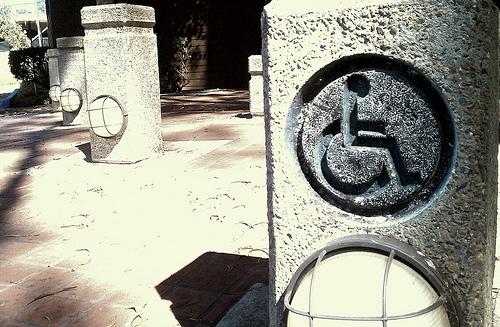


National Disability Employment Awareness Month (NDEAM) is halfway over, and the media has published many good stories demonstrating the 2012 theme: “A Strong Workforce Is An Inclusive Workforce: What Can YOU Do?,” established by the U.S. Department of Labor Office of Disability Employment Policy.
One of the best of the bunch comes from the ODEP’s Disability Blog, which last Wednesday ran this guest post from Susan Fleming, Ph.D., R.N. Fleming’s nursing career spans more than 30 years, fulfilling her girlhood dream of following in her great-grandmother’s footsteps. Fleming was born without a left hand, and she knew she would need help from her colleagues getting started in this “compassionate” but “hypercritical” profession.
An accompanying video produced by Washington State University, where Fleming is an assistant professor, shows her setting up IVs, tying gowns, and performing other complex manual labor tasks.
The takeaway from this video is how few patients probably even notice Fleming’s disability on a daily basis. And why should they? She is doing the job she has been trained to do with a level of skill equal to her peers. But Fleming is not content with being a good nurse and teacher. Through her work at WSU and on the board of ExceptionalNurse.com, she seeks to open more doors to nursing opportunities for people with disabilities worldwide. “I felt I could always give more than I ever took,” she says.
That sentiment is echoed by Gregg Nicklaus, co-owner of Sirata in St. Petersburg, Florida. The vacation resort has partnered with an area organization called Vincent House to provide a variety of jobs to people with disabilities. In this Tallahassee Democrat article, Nicklaus tells Tiffany Cowle that no matter whether the people they hire work in the pool hut, the gift shop, one of the restaurants, or on the grounds as maintenance crew, their work performance “exceeds our expectations and that of our guests.”
The desire to exceed expectations among individuals with disabilities is also seen in workers like Chad Guerrero, who works in the shipping department of a Lowe’s distribution center in Jenkins Township, Pennsylvania. Whether it’s at a company like Lowe’s or Walgreens or through a Contract Services organization, manual labor tasks like light assembly, sorting, packing, and shipping seem to be the area where more and more businesses can give work to people with disabilities in their community.
In this Citizens’ Voice article by Denise Allabaugh, Guerrero says it’s because people like him can do the job “just as well as anyone else, in fact, even better.” During a tour of the facility, Pennsylvania Governor Tom Corbett corroborate Guerrero’s tenacity with bottom line benefits:
The governor cited Lowe’s model as a ‘great example of what employers can do to diversify their workforce.’ By hiring people with disabilities, Corbett said there is less turnover and training and their safety rating is higher than the average worker. ‘Most of all, this occupation and this ability to have a job brings the dignity and independence they so rightfully deserve,’ Corbett said. ‘They pay it back by becoming outstanding members of the workforce here at Lowe’s or wherever this takes place.’
Use the comments section to share any stories you have about people with disabilities exceeding job expectations.
Image by Keoni Cabral.